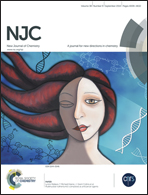Ground-state and excited-state multiple proton transfer via a hydrogen-bonded water wire for 3-hydroxypyridine
Abstract
In this work, the multiple proton transfer reactions in the ground and first excited states of 3-hydroxypyridine (3HP) in aqueous solution have been investigated by using density functional theory and time dependent density functional theory methods. The effect of a water wire (H2O⋯H2O⋯H2O) on the multiple proton transfer has been elucidated for 3HP. We have confirmed that the multiple proton transfer process can take place more easily in the excited state than in the ground state, and the zwitterionic cluster 3-pyridone-(H2O)3 (3Py-(H2O)3) is the optimal proton transfer product. For the case of neutral 3HP-(H2O)3 and zwitterionic 3Py-(H2O)3 clusters, the intermolecular hydrogen bonds are demonstrated to be significantly strengthened and weakened respectively in the excited state in comparison with those in the ground state, and these have been discussed in detail. Moreover, a conclusive description of the proton transfer cycle has been presented on the basis of our calculated transition energies and potential energy profiles. This photocycle can reasonably explain the absence of fluorescence of the 3HP species in the excited state.


 Please wait while we load your content...
Please wait while we load your content...